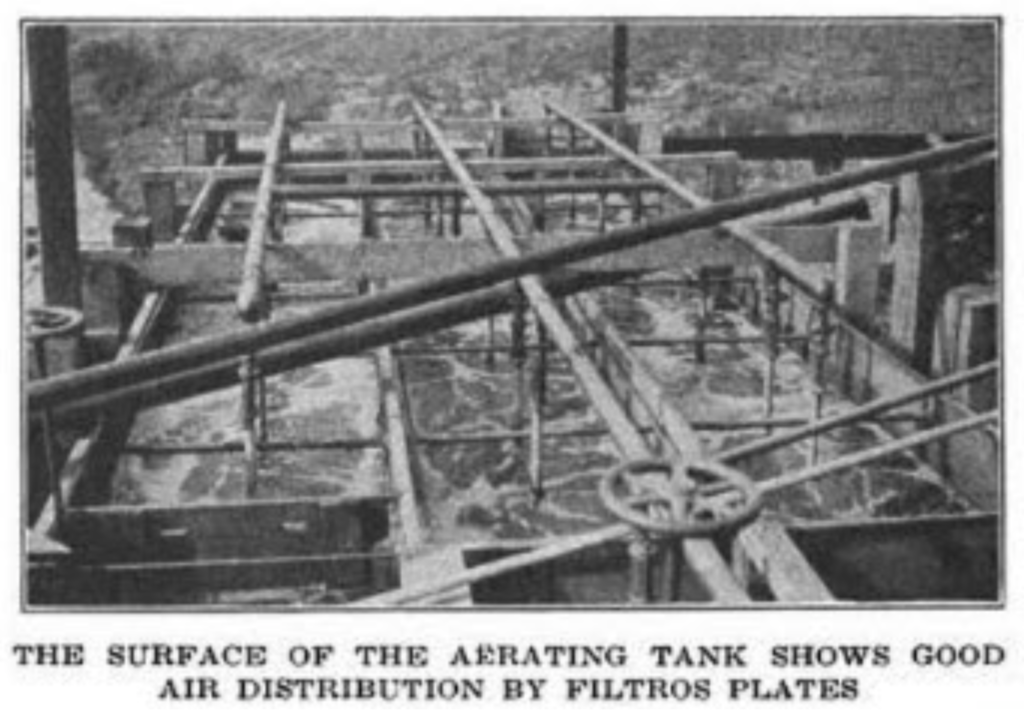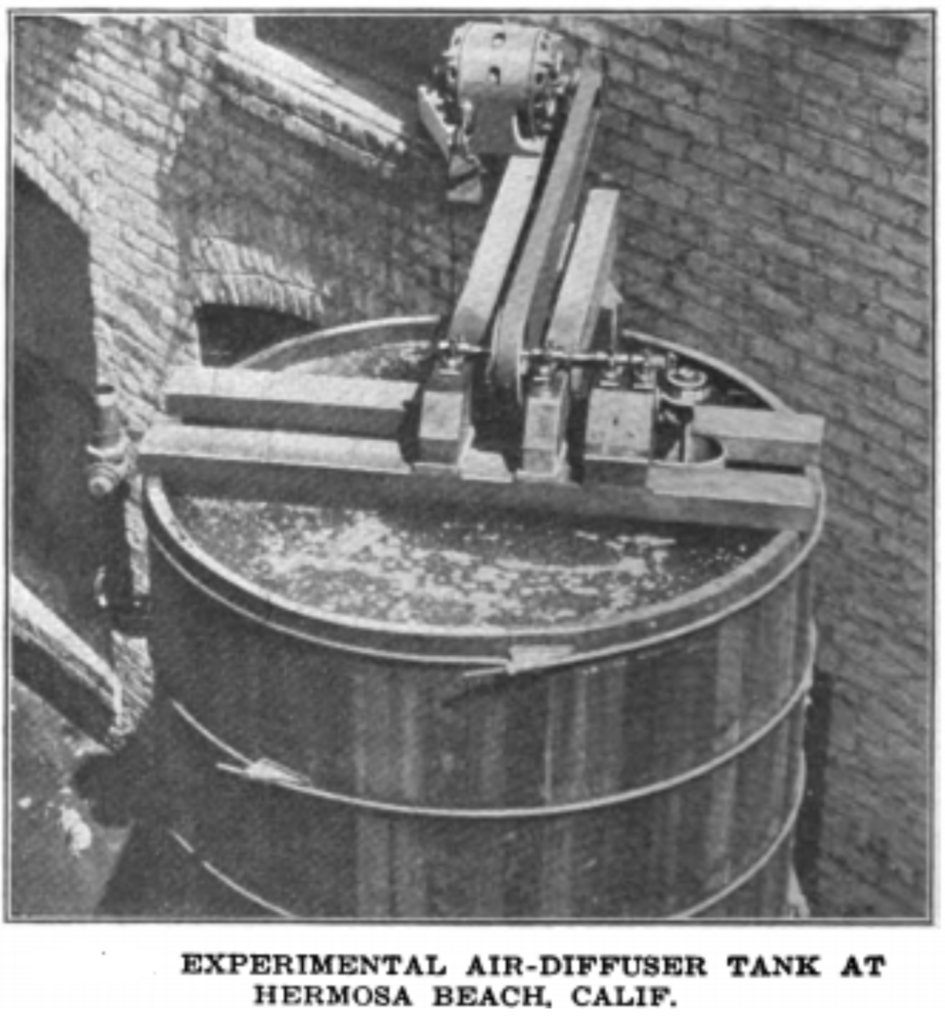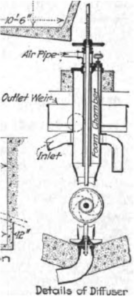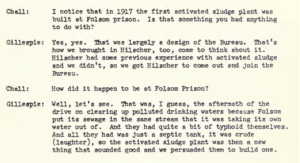This article describes some of the research process into the history and development of the activated sludge process in California. This research will be used for a paper that discusses the history of the activated sludge process in California from 1917 to 2017. If you have additional information on the early use of the activated sludge process in California that is not discussed or cited in this article, please contact the CWEA History Committee – we welcome the input.
The development and adoption of the activated sludge process in the early 20th century represented a significant “paradigm shift” for sewage treatment.1 When the activated sludge process was first presented in 1914 it was heralded as “epoch-making” and a “bombshell” development for sewage treatment and disposal.2 3
The development of the activated sludge process was indeed epoch-making because sewage treatment and disposal prior to the advent of activated sludge was dominated for the most part by disposal to land via sewage farming, tank treatment systems (septic tanks, Imhoff tanks followed by sprinkling filters), and chemical precipitation. The development of activated sludge signaled a shift to a more focused form of biological treatment involving the “harnessing of nature” through process control and an operational understanding of microbiology. Implementing this shift required the use of more and better developed technologies in the form of pumps, controls, aeration systems, instrumentation as well as the laboratory analyses and testing needed for effective process control. Additionally, the implementation of the activated sludge process led to the re-defining of sewage sludge as a resource, rather than a waste, during the 1920’s (most notably by the City of Milwaukee and its development of Milorganite® fertilizer and the City of Pasadena with its development of Nitrorganic fertilizer).
The older physical sewage treatment methods that predated activated sludge required less operational oversight and less process knowledge on the part of operators and plant staff. Thus, the shift to the activated sludge process required better trained and more knowledgeable operators – it signaled a shift to a more “scientific” process for the treatment of sewage. In turn, the requirement for better training and information played a major role in the development of professional wastewater associations like CWEA.
Due to the significance of the activated sludge process to our field and our Association, the CWEA History Committee decided to research and document its history in California. The Committee’s look at the history of the activated sludge process started approximately three years ago as a part of our overall research into our Association’s history.
The official “birthday” of the activated sludge process is April 3, 1914 when Edward Ardern and William T. Lockett of the Manchester Sewage Works (England) presented a paper to Society of the Chemical Industry describing the basic elements of the activated sludge process. The history of the developments leading up to Ardern and Lockett’s discovery or “invention” of the activated sludge process is well documented and will not covered here. What is important to this discussion is understanding that the spread of and adoption of the new process occurred very rapidly in both England and the United States. The speed of the adoption and application of this innovative new sewage treatment technology is illustrated by J. Edward Porter’s 1921 bibliography “The Activated Sludge Process of Sewage Treatment”. Porter’s bibliography lists abstracts for 601 papers and articles on activated sludge being published from 1914 to the end of 1920 – an average of 100 papers per year in the first six years of the new process!

Figure 1. City of Pasadena Activated Sludge Pilot Plant, 1917 (From Engineering News Record, November 29, 1917)
While documenting the history of the Association’s early award winning treatment plants and early Association leaders, I noted several references to “experimental” activated sludge plants (pilot plants) being used in California to test the feasibility of activated sludge for treating municipal sewage. What was remarkable to me about these references was how early the activated sludge process was being testing in California. Most notable were the references to the City of Pasadena’s activated sludge pilot plant being put into operation on January 29, 1917 (see Figure 1). The Pasadena pilot plant was developed to test the efficiency of activated sludge as compared to sewage treatment via Imhoff tanks followed by sprinkling filters in a “competition” to select between available sewage treatment plant processes (for further discussion, see Wastewater Professional, April 2015).
Given that the activated sludge process was discovered (or invented, depending on how you view it) in 1914, the adoption of the activated sludge process by a California municipality in less than 3 years from its discovery is truly amazing – especially considering how technical information was communicated at the time!
The information on Pasadena’s pilot plant led to the questions of when and where the activated sludge process was first used in California. Was Pasadena the first activated sludge plant in California? If so, this might help to determine the centennial year for activated sludge in California. The search for the first California activated sludge sewage treatment plant was on!
Determining when and where the first activated sludge sewage treatment plant was placed into operation required searching through the California Bureau of Sanitary Engineering’s papers held in the Water Resources Archives at UC Riverside, along with reviews of the Engineering News Record (ENR) from the years in question and reviews of the on-line California newspaper archives. Pacific Municipalities (the quarterly publication of the old League of Pacific Municipalities) was also reviewed, as were the weekly bulletins from the California State Board of Health (for Bureau of Sanitary Engineering news).
The Bureau of Sanitary Engineering’s records provide information on sewage treatment plant reviews, inspections and permits issued for new plants, while the old ENR’s provide information on bids, design and construction of sewage treatment plants. The newspaper archives and issues of Pacific Municipalities are useful for providing background information on sewage treatment plant bond financing campaigns, plant construction and operational topics. The Board of Health weekly bulletins focus on inspections and problems related to sewage treatment plants of the era being researched. Taken together, these sources of information can be used to paint a fairly complete picture of the events related to sewage treatment and disposal in California from 1914 through the 1920’s.
 Fig 2. Wooden Barrel “Brosius” Pilot Plant – Testing Aeration of Clean Water (From Engineering News Record, November 9, 1916)
Fig 2. Wooden Barrel “Brosius” Pilot Plant – Testing Aeration of Clean Water (From Engineering News Record, November 9, 1916)Working back through the records, I noted that the 1917 ENR Pasadena pilot plant article mentioned that the City of Hermosa Beach was also pilot testing a variation of the activated sludge process. Specifically, the 1917 article stated that the City of Hermosa Beach was using a pilot plant designed by a Mr. A.M. Brosius to test a “diffuser wheel (impeller pump) and foam chamber” as an alternative to using compressed air and diffusers for aeration. The article went on to say that the City of Hermosa’s tests of the “Brosius plant” were inconclusive due to several plant breakdowns and referenced an earlier ENR article dated November 19, 1916 describing the Brosius plant. Could the Hermosa Beach pilot plant be the first time the activated sludge was used in California? And, if Hermosa Beach was pilot testing the activated sludge process, did the testing result in the construction of a full-scale activated sludge sewage treatment plant?
The 1916 ENR article verified that the City of Hermosa Beach had constructed an “experimental plant” in 1916 to conduct tests of the activated sludge process using the Brosius diffuser wheel design. The City was interested in using the process due to the lack of large parcels of land within the City limits needed for constructing the typical sewage treatment plant using processes that were prevalent in the early 1900’s (the City of Hermosa’s sewage was being unsatisfactorily treated by a septic tank in 1916).

Figure 3. Brosius “Diffuser Wheel” Aerator Design for the City of Hermosa Beach 1916 (From Engineering News Record, November 9, 1916)
The Brosius activated sludge pilot plant consisted of a 5-foot diameter wooden barrel with a water depth of 9.5 feet. A series of experimental diffusers were installed in the barrel for testing and the barrel was equipped with glass observation portholes at 1, 2, 4 and 5 feet from its bottom (see Figures 2).
The innovative diffuser design was not entirely successful and compressed air had to be added to achieve the required aeration rate and mixing. A.M. Brosius proceeded with the design for a 0.4 mgd activated sludge plant and the plans were approved by the City Engineer and City of Hermosa Beach Board of Trustees for construction with a targeted completion and start-up in early 1917. Figure 3. shows the design of the diffuser wheel aeration system for the proposed sewage treatment plant.
Unfortunately, the bond issue election for the new treatment plant failed to carry and the City of Hermosa Beach sewage treatment plant was never constructed. The City of Hermosa Beach subsequently contracted with the City of Los Angeles for sewage disposal and later with Los Angeles County Sanitation Districts.
The Hermosa Beach pilot plant was now documented as the first experimental or pilot activated sludge process plant in California. However, the available information on the City of Hermosa Beach pilot plant only referred to aeration tests using “clean water” to test the aeration, so it was uncertain as to whether sewage was ever tested in the pilot plant. In comparison, the City of Pasadena’s pilot plant was documented as actually treating sewage in 1917 in a fully developed process, so would it claim the title of “first”?
Experimental or pilot plants might be considered as a “first”, but the question remained as to when and where California’s first full-scale activated sludge plant was constructed and put into operation. In my opinion, to truly qualify as “first”, the treatment plant should be a full-scale, operational activated sludge sewage treatment facility successfully discharging a treated effluent (as opposed to a temporary testing facility). The City of Hermosa Beach experimental plant did not meet the basic definition and the uncertainty about the use sewage during the pilot testing further eliminated it from consideration as the “first”. Pasadena’s activated sludge pilot plant operated from 1917 to 1919, but it was a temporary facility and did not meet the “full-scale” criteria.
Interestingly, the answer to the questions of when and where for the “first full-scale permanent activated sludge treatment facility in California” popped up in an unexpected place. While researching the life of Chester G. Gillespie, first Chief of the Bureau of Sanitary Engineering, State Department of Health and “founding father” of our Association, I came across some the following statements in the transcripts of an interview with Gillespie (see Figure 4. below):

Figure 4. (From Chester G. Gillespie “Origins and Early Years of the Bureau of Sanitary Engineering” Regents of the University of California, 1971)
This transcript was the clue I had been searching for, however, it did not positively confirm that the Folsom State Prison sewage treatment plant was operational in 1917. Using the 1917 date, the next step was to review the 1917 ENR’s and Bureau of Sanitary Engineering Documents to determine when the Folsom State Prison plant was placed into operation. The review was simplified by using J. Edward Porter’s 1921 biography as the key to finding published records on the Folsom plant.
Porter’s bibliography had the following abstract from the December 13, 1917 ENR (see Figure 5. below):
A quick review of the ENR article confirmed that the Folsom State Prison Sewage Treatment Plant was constructed and started operation in 1917. Additionally, Porter’s bibliography had the following ENR abstract listing from 1920 regarding Folsom State Prison’s sewage treatment plant (see Figure 6. Below):
The complete 1920 ENR article noted that the Folsom State Prison sewage treatment plant had no operational problems and performed well, even though the convict labor operating the plant was not reliable. The 1920 ENR entry is significant historically because it confirms that the Folsom State Prison sewage treatment plant was the only operating full-scale activated sludge sewage treatment plant in California from 1917 until at least mid-1920.
The “when and where” questions were answered – 2017 was confirmed as the official centennial year of the activated sludge process in California and Folsom State Prison as the first agency/place using the activated sludge process.
As a side-note, the 1917 Folsom State Prison sewage treatment plant utilized a diffused aeration system which was later replaced with mechanical aerators when the plant was updated and expanded in 1932 (see Figure 7.)
Figure 7. Folsom State Prison Sewage Treatment Plant 1932 (From Sewage Works Journal, July 1932)
There was a lag of almost four years before the next full-scale activated sludge sewage treatment plant was constructed in California. During this lag period, pilot testing continued in California and the construction and start-up of activated sludge sewage re-started with a series of “firsts” in terms of the application of the process. The following is the list of milestones based on the CWEA History Committee’s initial research:
Figure 8 (below) provides more detail on these milestone facilities and some additional information on pilot testing in California. In most cases, there are direct connections to our Association and its leadership and programs (noted in Figure 8.).
The successful adoption and application of a new wastewater technology depends on several factors including how the technology is communicated and understood, who takes the lead in adopting and implementing the technology and how the technology is supported. The early history of the activated sludge process in California clearly demonstrates that the future leadership of the California Sewage Works Association (now CWEA) had an active role in the adoption and implementation of the process and, with the establishment of the Association, provided the necessary support for the communication and dissemination of the training and information needed to support the successful on-going application of new technologies for sewage collection, treatment and reuse in California.
1 Note: The terms “sewage” and “sewage sludge” are used in this article in keeping with the historical context of the discussion.
2 William B. Fuller, “Sewage Disposal by the Activated Sludge Process: An Epoch-Making Discovery”, The American City Vol. 14, No. 1, (January 1916), pp. 78-81
3 James E. Alleman and T.B.S. Prakasam, “Reflections on Seven Decades of AS History”, Journal of the Water Pollution Control Federation, Vol. 55, No. 5 (May, 1983), pp. 436-443